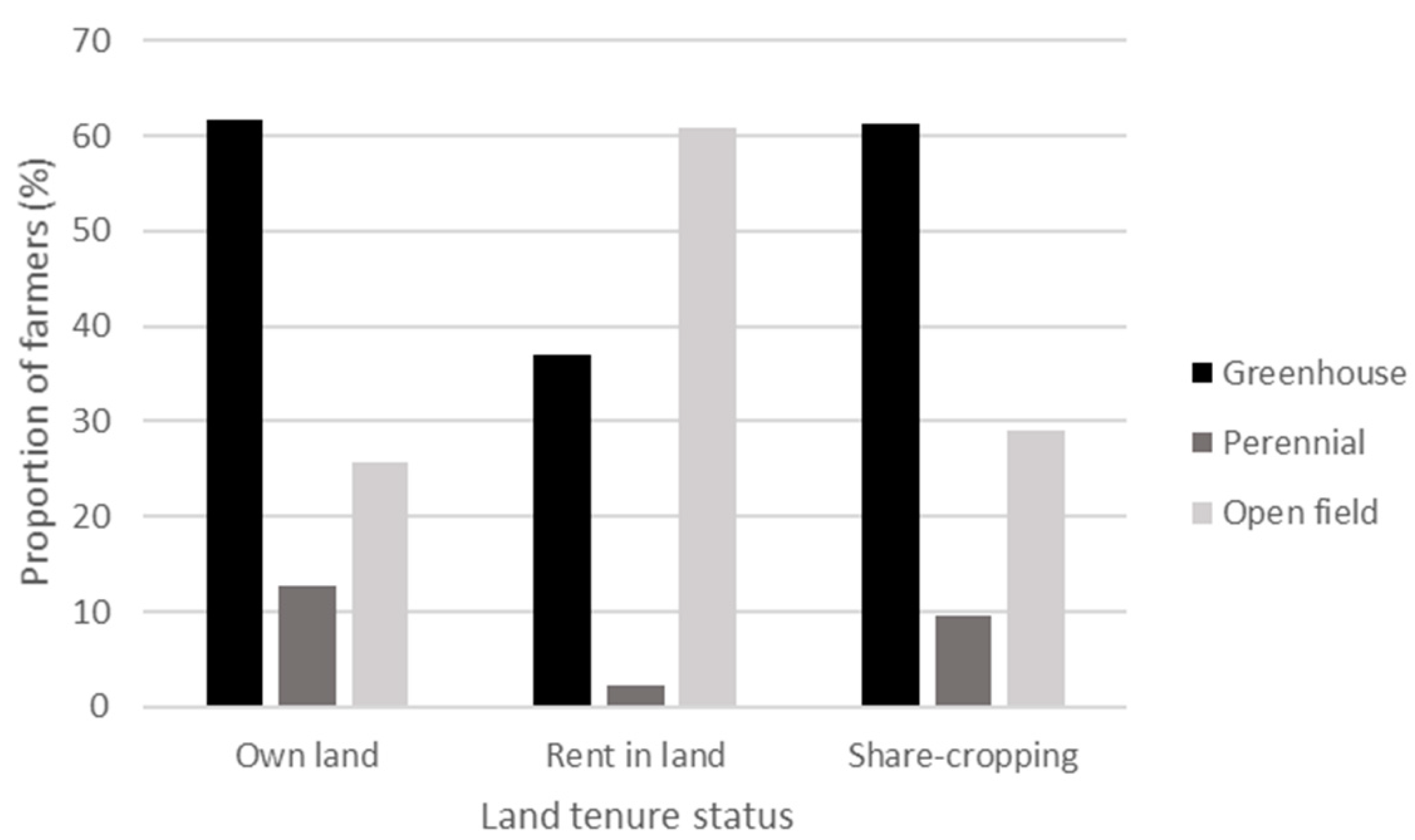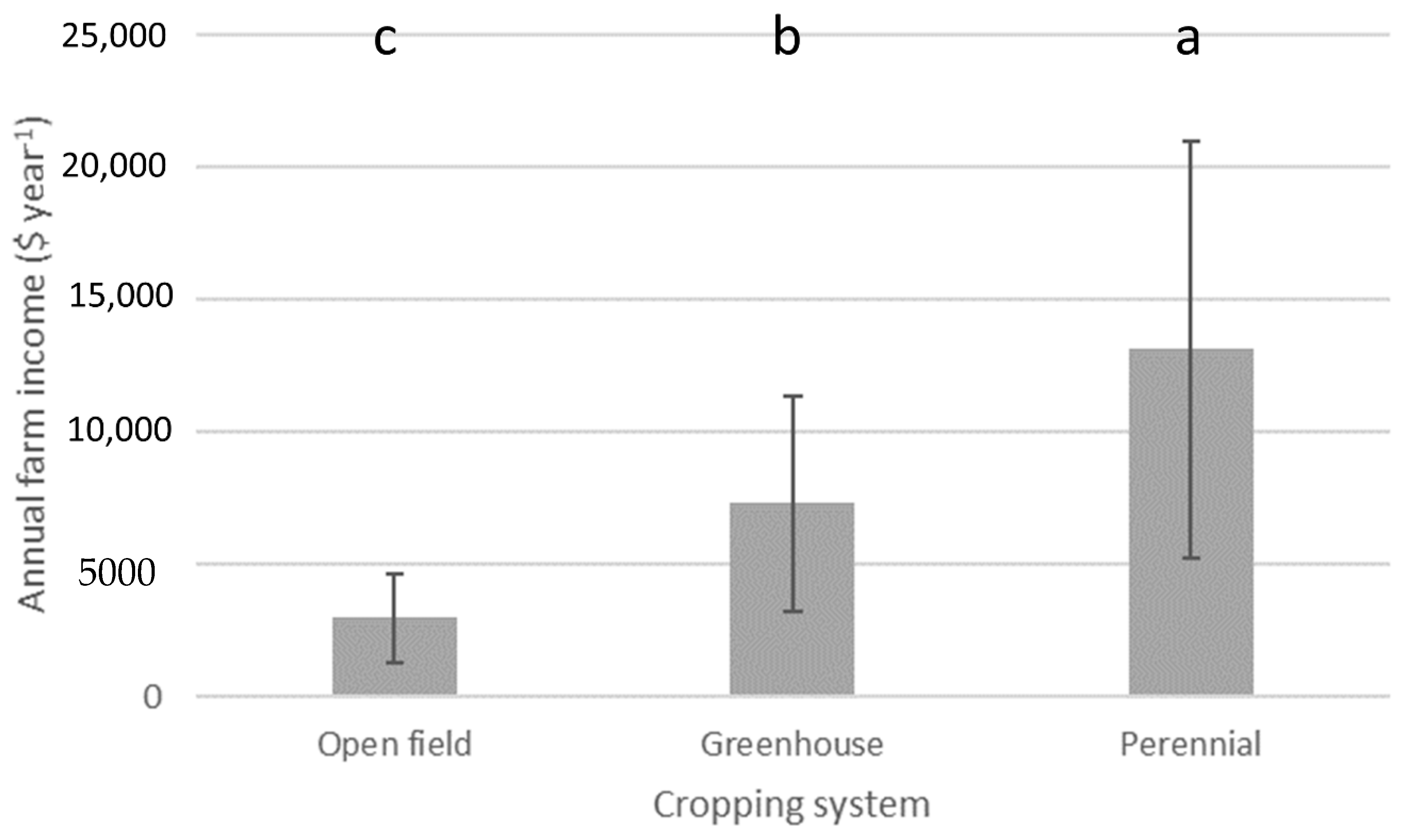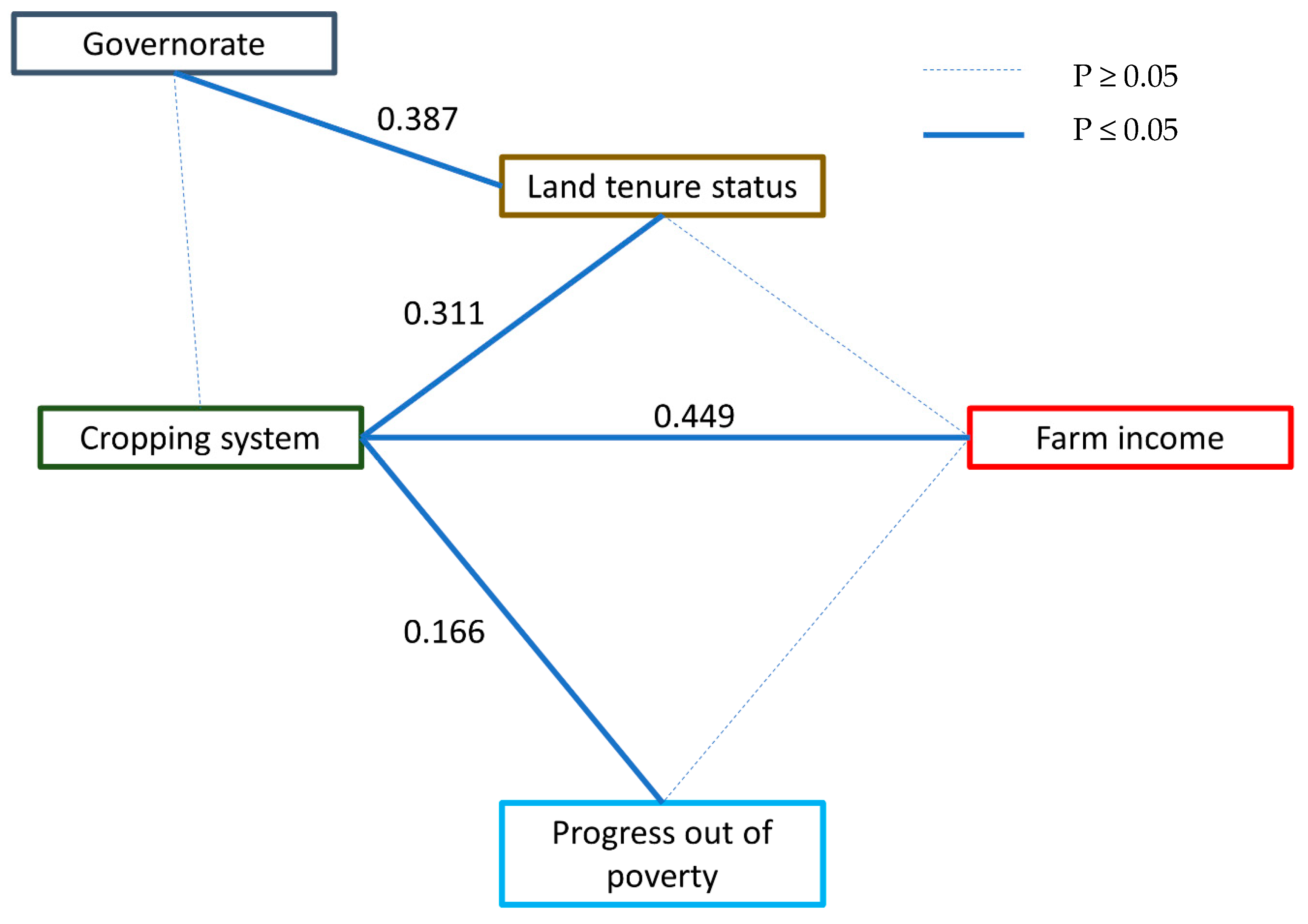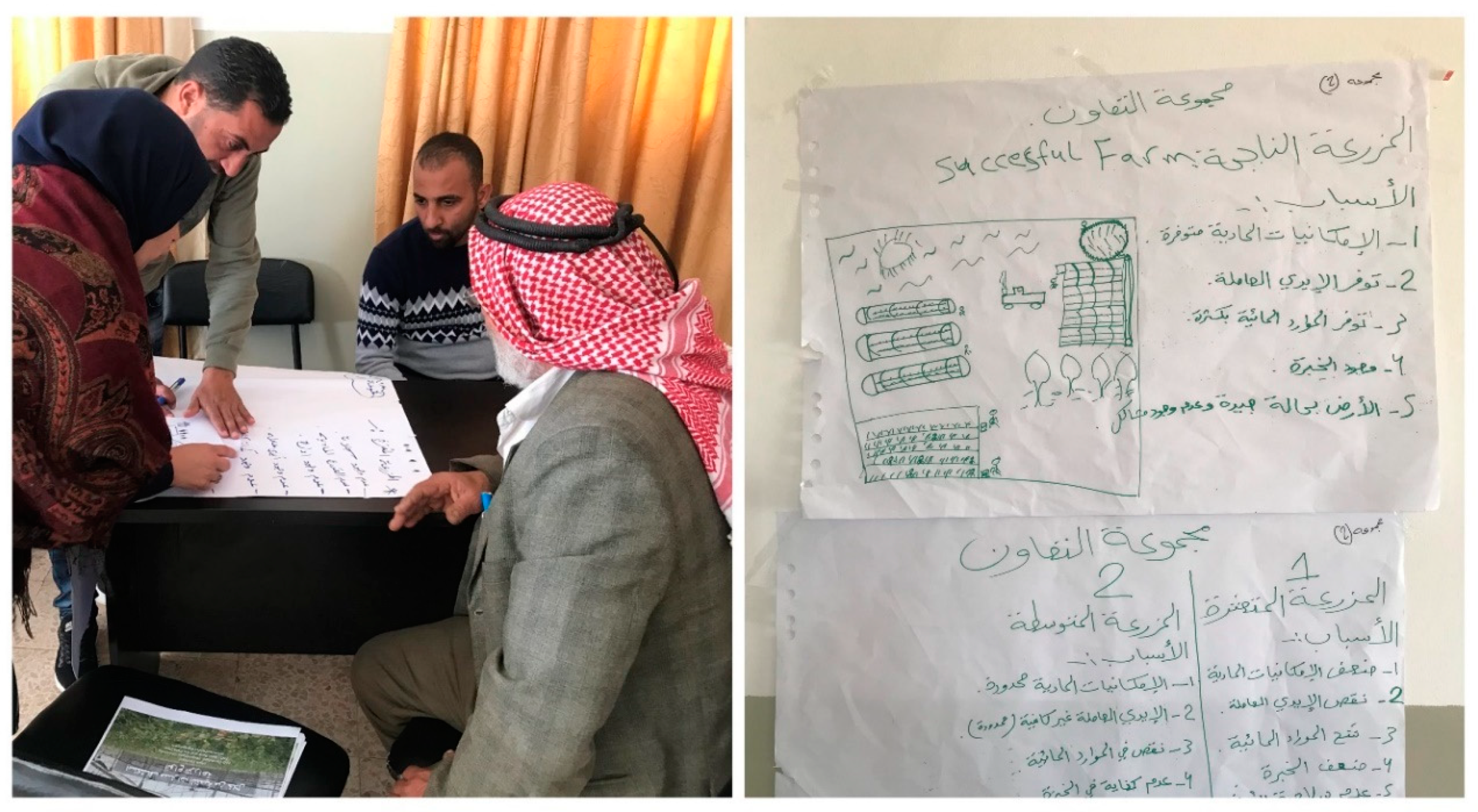Land Tenure Insecurity Constrains Cropping System Investment in the Jordan Valley of the West Bank
Abstract
1. Introduction
Farming, Agricultural Development, and Land Tenure Status
2. Materials and Methods
2.1. Study Site
2.2. Rural Household Multi-Indicator Survey
2.3. Pathways to Development Stakeholder Interviews and Workshops
2.4. Statistical Analysis
3. Results
3.1. Farming Household and Farm Management Characteristics by Governorate
3.2. Primary Cropping System by Land Tenure Status
3.3. Farming Household and Farm Management Characteristics by Land Tenure Status
3.4. Structural Equation Model Results
3.5. Pathways to Development Stakeholder Interviews and Workshops
4. Discussion
4.1. Land Tenure Status Influences Farm Income Via Cropping Systems Investments
4.2. Sharecropping as a Special Case of More Secure Land Tenure Status
4.3. Land Tenure, Food Self-Sufficiency and Gender
5. Conclusions
Author Contributions
Funding
Acknowledgments
Conflicts of Interest
References
- Graeub, B.E.; Chappell, M.J.; Wittman, H.; Ledermann, S.; Kerr, R.B.; Gemmill-Herren, B. The State of Family Farms in the World. World Dev. 2016, 87, 1–15. [Google Scholar] [CrossRef]
- Rapsomanikis, G. The Economic Lives of Smallholder Farmers; FAO: Rome, Italy, 2015. [Google Scholar]
- Oxfam. On the Brink: Israeli Settlements and Their Impact on Palestinians in the Jordan Valley; Oxfam: Nairobi, Kenya, 2012; Volume 10. [Google Scholar]
- Palestine Economic Policy Research Institute. Economic Monitor; Palestine Economic Policy Research Institute: Ramallah, Palestine, 2016. [Google Scholar]
- Isaac, J.; Ghattas, R.; Hrimat, N. Palestinian Agricultural Production and Marketing between Reality and Challenges: Executive Summary for a Research Study; ARIJ: Jerusalem, Israel, 2015. [Google Scholar]
- Nori, M.; Triandafyllidou, A. Mediterranean Interfaces: Agriculture, Rural Development and Migration. Forward-Looking Policies and Programmes for an Integrated Approach; Cadmus: Florence, Italy, 2019. [Google Scholar]
- Birner, R.; Resnick, D. The Political Economy of Policies for Smallholder Agriculture. World Dev. 2010, 38, 1442–1452. [Google Scholar] [CrossRef]
- Hazell, P.; Poulton, C.; Wiggins, S.; Dorward, A. The Future of Small Farms: Trajectories and Policy Priorities. World Dev. 2010, 38, 1349–1361. [Google Scholar] [CrossRef]
- Panichvejsunti, T.; Kuwornu, J.K.M.; Shivakoti, G.P.; Grünbühel, C.; Soni, P. Smallholder farmers’ crop combinations under different land tenure systems in Thailand: The role of flood and government policy. Land Use Policy 2018, 72, 129–137. [Google Scholar] [CrossRef]
- Scopel, E.; Triomphe, B.; Affholder, F.; Da Silva, F.A.M.; Corbeels, M.; Xavier, J.H.V.; Lahmar, R.; Recous, S.; Bernoux, M.; Blanchart, E.; et al. Conservation agriculture cropping systems in temperate and tropical conditions, performances and impacts. A review. Agron. Sustain. Dev. 2013, 33, 113–130. [Google Scholar] [CrossRef]
- Ostrom, E.; Cox, M. Moving beyond panaceas: A multi-tiered diagnostic approach for social-ecological analysis. Environ. Conserv. 2010, 37, 451–463. [Google Scholar] [CrossRef]
- Liu, J.; Dietz, T.; Carpenter, S.R.; Alberti, M.; Folke, C.; Moran, E.; Pell, A.N.; Deadman, P.; Kratz, T.; Lubchenco, J.; et al. Complexity of Coupled Human and Natural Systems. Science 2007, 317, 1513–1516. [Google Scholar] [CrossRef] [PubMed]
- Ostrom, E. A general framework for analyzing sustainability of social-ecological systems. Science 2009, 325, 419–422. [Google Scholar] [CrossRef]
- Cumming, G.S.; Barnes, G.; Southworth, J. Environmental Asymmetries. In Complexity Theory for a Sustainable Future; Columbia University Press: New York, NY, USA, 2008; pp. 17–45. ISBN 9780231134613. [Google Scholar]
- Tittonell, P. Livelihood strategies, resilience and transformability in African agroecosystems. Agric. Syst. 2014, 126, 3–14. [Google Scholar] [CrossRef]
- Hemming, D.J.; Chirwa, E.W.; Dorward, A.; Ruffhead, H.J.; Hill, R.; Osborn, J.; Langer, L.; Harman, L.; Asaoka, H.; Coffey, C.; et al. Agricultural input subsidies for improving productivity, farm income, consumer welfare and wider growth in low- and lower-middle-income countries: A systematic review. Campbell Syst. Rev. 2018, 14, 1–153. [Google Scholar] [CrossRef]
- Nahayo, A.; Omondi, M.O.; Zhang, X.H.; Li, L.Q.; Pan, G.X.; Joseph, S. Factors influencing farmers’ participation in crop intensification program in Rwanda. J. Integr. Agric. 2017, 16, 1406–1416. [Google Scholar] [CrossRef]
- Zeng, D.; Alwang, J.; Norton, G.; Jaleta, M.; Shiferaw, B.; Yirga, C. Land ownership and technology adoption revisited: Improved maize varieties in Ethiopia. Land Use Policy 2018, 72, 270–279. [Google Scholar] [CrossRef] [PubMed]
- Delgado, J.A.; Barrera Mosquera, V.H.; Escudero López, L.O.; Cartagena Ayala, Y.E.; Alwang, J.R.; Stehouwer, R.C.; Arévalo Tenelema, J.C.; D’Adamo, R.; Domínguez Andrade, J.M.; Valverde, F.; et al. Conservation Agriculture Increases Profits in an Andean Region of South America. Agrosystems Geosci. Environ. 2019, 2, 1–8. [Google Scholar] [CrossRef]
- Mattia, C.M.; Lovell, S.T.; Davis, A. Identifying barriers and motivators for adoption of multifunctional perennial cropping systems by landowners in the Upper Sangamon River Watershed, Illinois. Agrofor. Syst. 2018, 92, 1155–1169. [Google Scholar] [CrossRef]
- Mensah-Bonsu, A.; Sarpong, D.B.; Al-Hassan, R.; Egyir, I.S.; Asuming-Brempong, S.; Egyir, I.S.; Kuwornu, J.K.M.; Osei-Asare, Y.B. Intensity of and factors affecting land and water management practices among smallholder maize farmers in Ghana. Afr. J. Agric. Resour. Econ. 2017, 12, 142–157. [Google Scholar]
- Muzari, W.; Gatsi, W.; Muvhunzi, S. The Impacts of Technology Adoption on Smallholder Agricultural Productivity in Sub-Saharan Africa: A Review. J. Sustain. Dev. 2012, 5, 69–77. [Google Scholar] [CrossRef]
- Place, F. Land Tenure and Agricultural Productivity in Africa: A Comparative Analysis of the Economics Literature and Recent Policy Strategies and Reforms. World Dev. 2009, 37, 1326–1336. [Google Scholar] [CrossRef]
- Paltasingh, K.R. Land tenure security and adoption of modern rice technology in Odisha, Eastern India: Revisiting Besley’s hypothesis. Land Use Policy 2018, 78, 236–244. [Google Scholar] [CrossRef]
- Saudubray, F.; Scherer, C. Land Tenure Management: A Key Determinant of Sustainable Farming in Martinique. J. Sustain. Agric. 2007, 29, 13–28. [Google Scholar] [CrossRef]
- Soule, M.J.; Tegene, A.; Wiebe, K.D. Land Tenure and the Adoption of Conservation Practices. Am. J. Agric. Econ. 2000, 82, 993–1005. [Google Scholar] [CrossRef]
- Tefera, B.; Sterk, G. Land management, erosion problems and soil and water conservation in Fincha’a watershed, western Ethiopia. Land Use Policy 2010, 27, 1027–1037. [Google Scholar] [CrossRef]
- Walmsley, A.; Sklenička, P. Various effects of land tenure on soil biochemical parameters under organic and conventional farming—Implications for soil quality restoration. Ecol. Eng. 2017, 107, 137–143. [Google Scholar] [CrossRef]
- Nkomoki, W.; Bavorová, M.; Banout, J. Adoption of sustainable agricultural practices and food security threats: Effects of land tenure in Zambia. Land Use Policy 2018, 78, 532–538. [Google Scholar] [CrossRef]
- Lawin, K.G.; Tamini, L.D. Land Tenure Differences and Adoption of Agri-Environmental Practices: Evidence from Benin. J. Dev. Stud. 2019, 55, 177–190. [Google Scholar] [CrossRef]
- Varble, S.; Secchi, S.; Druschke, C.G. An Examination of Growing Trends in Land Tenure and Conservation Practice Adoption: Results from a Farmer Survey in Iowa. Environ. Manag. 2016, 57, 318–330. [Google Scholar] [CrossRef]
- Bandiera, O. Land tenure, investment incentives, and the choice of techniques: Evidence from Nicaragua. World Bank Econ. Rev. 2007, 21, 487–508. [Google Scholar] [CrossRef]
- CIHEAM (International Centre for Advanced Mediterranean Agronomic Studies); FAO (Food and Agriculture Organization of the United Nations). MediTerra: Zero Waste in the Mediterranean. Natural Resources, Food, and Knowledge; Presses de Sciences Po: Paris, France, 2016; ISBN 9782724619218. [Google Scholar]
- Casini, M.; Bastianoni, S.; Gagliardi, F.; Gigliotti, M.; Riccaboni, A.; Betti, G. Sustainable development goals indicators: A methodological proposal for a multidimensional fuzzy index in the mediterranean area. Sustainability 2019, 11, 1198. [Google Scholar] [CrossRef]
- Gray, C.L. Rural out-migration and smallholder agriculture in the southern Ecuadorian Andes. Popul. Environ. 2009, 30, 193–217. [Google Scholar] [CrossRef]
- Rao, F.; Spoor, M.; Ma, X.; Shi, X. Land tenure (in)security and crop-tree intercropping in rural Xinjiang, China. Land Use Policy 2016, 50, 102–114. [Google Scholar] [CrossRef]
- Kool, J. Sustainable Development in the Jordan Valley Final Report of the Regional NGO Master Plan; Springer: Cham, Switzerland, 2016; Volume 13, ISBN 9783319300351. [Google Scholar]
- Hammond, J.; Fraval, S.; van Etten, J.; Suchini, J.G.; Mercado, L.; Pagella, T.; Frelat, R.; Lannerstad, M.; Douxchamps, S.; Teufel, N.; et al. The Rural Household Multi-Indicator Survey (RHoMIS) for rapid characterisation of households to inform climate smart agriculture interventions: Description and applications in East Africa and Central America. Agric. Syst. 2017, 151, 225–233. [Google Scholar] [CrossRef]
- Van Wijk, M.; Hammond, J.; Gorman, L.; Adams, S.; Ayantunde, A.; Baines, D.; Bolliger, A.; Bosire, C.; Carpena, P.; Chesterman, S.; et al. The Rural Household Multiple Indicator Survey, data from 13,310 farm households in 21 countries. Sci. Data 2020, 7, 1–9. [Google Scholar] [CrossRef] [PubMed]
- Desiere, S.; Vellema, W.; D’Haese, M. A validity assessment of the Progress out of Poverty Index (PPI)TM. Eval. Program Plan. 2015, 49, 10–18. [Google Scholar] [CrossRef] [PubMed]
- Wannasai, N.; Shrestha, R.P. Role of land tenure security and farm household characteristics on land use change in the Prasae Watershed, Thailand. Land Use Policy 2008, 25, 214–224. [Google Scholar] [CrossRef]
- Smith, R.E. Land tenure, fixed investment, and farm productivity: Evidence from Zambia’s southern province. World Dev. 2004, 32, 1641–1661. [Google Scholar] [CrossRef]
- Aha, B.; Ayitey, J.Z. Biofuels and the hazards of land grabbing: Tenure (in)security and indigenous farmers’ investment decisions in Ghana. Land Use Policy 2017, 60, 48–59. [Google Scholar] [CrossRef]
- Besley, T. Property rights and investment incentives: Theory and evidence from Ghana. J. Political Econ. 1995, 103, 903–937. [Google Scholar] [CrossRef]
- Norberg, J.; Cumming, G.S. Complexity Theory for a Sustainable Future; Columbia University Press: New York, NY, USA, 2008; ISBN 0231508867. [Google Scholar]
- Keovilignavong, O.; Suhardiman, D. Linking land tenure security with food security: Unpacking farm households’ perceptions and strategies in the rural uplands of Laos. Land Use Policy 2020, 90. [Google Scholar] [CrossRef]
- Caulfield, M.; Bouniol, J.; Fonte, S.J.; Kessler, A. How rural out-migrations drive changes to farm and land management: A case study from the rural Andes. Land Use Policy 2019, 81, 594–603. [Google Scholar] [CrossRef]
- Brandt, R.; Kaenzig, R.; Lachmuth, S. Migration as a Risk Management Strategy in the Context of Climate Change: Evidence from the Bolivian Andes. In Migration, Risk Management and Climate Change: Evidence and Policy Responses; Springer: Cham, Switzerland, 2016; pp. 43–61. [Google Scholar]
- Serrat, O. The Sustainable Livelihoods Approach. In Knowledge Solutions: Tools, Methods, and Approaches to Drive Organizational Performance; Springer: Singapore, 2017; pp. 21–26. ISBN 9789811009839. [Google Scholar]
- European Training Foundation. Labour Market and Employment Policies in Palestine; European Training Foundation: Torino, Italy, 2014.
- Abdulai, A.; Owusu, V.; Goetz, R. Land tenure differences and investment in land improvement measures: Theoretical and empirical analyses. J. Dev. Econ. 2011, 96, 66–78. [Google Scholar] [CrossRef]
- Sakurai, T. Intensification of rainfed lowland rice production in West Africa: Present status and potential green revolution. Dev. Econ. 2006, 44, 232–251. [Google Scholar] [CrossRef]
- Nguyen, T.T.; Bauer, S.; Grote, U. Does land tenure security promote manure use by farm households in Vietnam? Sustainability 2016, 8, 178. [Google Scholar] [CrossRef]
- Mariara, J.K.; Linderhof, V.; Kruseman, G. Does Land Tenure Security Matter for Investment in Soil and Water Conservation? Evidence From Kenya. Afr. J. Agric. Resour. Econ. 2010, 4, 123–139. [Google Scholar]
- Álvarez, A.M.; Carral, P.; Hernández, Z.; Almendros, G. Assessment of Soil Organic Matter Molecular Characteristics Related to Hydrophysical Properties in Semiarid Soils (Central Spain). Arid Land Res. Manag. 2013, 27, 303–326. [Google Scholar] [CrossRef]
- Buchmann, C.; Schaumann, G.E. The contribution of various organic matter fractions to soil–water interactions and structural stability of an agriculturally cultivated soil. J. Plant Nutr. Soil Sci. 2018, 181, 586–599. [Google Scholar] [CrossRef]
- Wood, S.A.; Bradford, M.A. Leveraging a New Understanding of how Belowground Food Webs Stabilize Soil Organic Matter to Promote Ecological Intensification of Agriculture. In Soil Carbon Storage; Elsevier: Amsterdam, The Netherlands, 2018; pp. 117–136. [Google Scholar]
- Moore, J.C.; Berlow, E.L.; Coleman, D.C.; De Suiter, P.C.; Dong, Q.; Hastings, A.; Johnson, N.C.; McCann, K.S.; Melville, K.; Morin, P.J.; et al. Detritus, trophic dynamics and biodiversity. Ecol. Lett. 2004, 7, 584–600. [Google Scholar] [CrossRef]
- Sen, D. Sharecropping in Theory and Practice: A Selective Review. In Understanding Development: An Indian Perspective on Legal and Economic Policy; Banerjee, S., Mukherjee, V., Haldar, S.K., Eds.; Springer: Cham, Switzerland, 2015; pp. 1–272. ISBN 9788132224556. [Google Scholar]
- Ray, T. Sharecropping, Land Exploitation and Land Improving Investments. Agric. Econ. 2004, 56, 127–143. [Google Scholar] [CrossRef]
- Ofuoku, A.U. Sharecropping Contract Experience in Delta State, Nigeria. J. Notheast Agric. Univ. 2015, 22, 62–68. [Google Scholar] [CrossRef]
- Holden, S.T.; Ghebru, H. Land tenure reforms, tenure security and food security in poor agrarian economies: Causal linkages and research gaps. Glob. Food Secur. 2016, 10, 21–28. [Google Scholar] [CrossRef]
- Pritchard, B.; Rammohan, A.; Sekher, M. Land ownership, agriculture, and household nutrition: A case study of north Indian villages. Geogr. Res. 2017, 55, 180–191. [Google Scholar] [CrossRef]
- Mwesigye, F.; Guloba, M.; Barungi, M. Women’s Land Rights and Agricultural Productivity in Uganda. In Women and Sustainable Human Development; Springer International Publishing: Cham, Switzerland, 2020; pp. 71–88. [Google Scholar]
- Melesse, T.M.; Awel, Y.M. Land Tenure, Gender, and Productivity in Ethiopia and Tanzania. In Women and Sustainable Human Development; Springer International Publishing: Cham, Switzerland, 2020; pp. 89–108. [Google Scholar]
- Mizyed, N.; Sahar, J.; Saleh Ayasa, A. The Status of Land Tenure, Planning and Management in the West Bank and Gaza Strip; FAO: Jerusalem, Israel, 2015. [Google Scholar]
- Namubiru-Mwaura, E. Gender Equality & Development, Land Tenure and Gender: Approaches and Challenges for Strenghtening Rural Women’s Land Rights; World Bank: Washington, DC, USA, 2014; Volume 6, pp. 1–30. [Google Scholar]




| Variable Type | Variable | Description |
|---|---|---|
| Main predictor variables | Governorate | Jericho, Nablus or Tubas |
| Land tenure status | Owned-land, rented land or sharecropping | |
| Cropping system | Greenhouse, open field or perennial production systems | |
| Household characteristics | Average age of HHH (years) | The (average) age of the household head(s) |
| Size of household (members) | Number of family members living in the household | |
| Progress out of poverty index (PPI) | A country-specific indicator of poverty, based on ten closed questions on directly observable household characteristics [40] | |
| Food self-sufficiency (Kcal MAE−1 day−1) | Amount of food energy generated by consumption of farm produce | |
| Female participation in decision-making | Relative control of adult female over the potential total food energy available | |
| Farm economics | Farm income (USD year−1) | Total amount of cash generated by farm sales |
| Production value (USD ha−1 year−1) | Total amount of cash generated by farm sales divided by area of land cultivated | |
| Market orientation (scale 0–1) | Relative importance of crop sales in generating potential total food energy available | |
| Membership of a cooperative (%) | Membership of a cooperative | |
| Farm management characteristics | Land cultivated (ha) | Area of land cultivated |
| N fertilizer inputs (kg ha−1 year−1) | Amount of nitrogen applied on farm through chemical fertilizer | |
| Manure inputs (kg ha−1 year−1) | Amount of manure applied on farm | |
| Irrigation inputs (m³ ha−1 year−1) | Amount of irrigation water applied on farm | |
| Crop diversity (number of crops) | Number of different crops grown |
| Variable | Governorate | |||
|---|---|---|---|---|
| Jericho | Nablus | Tubas | ||
| Farming households surveyed | 65 | 68 | 96 | |
| Land tenure | Own land | 34 | 62 | 61 |
| Rent in land | 2 | 0 | 34 | |
| Sharecropping | 29 | 6 | 1 | |
| Cropping system | Greenhouse | 37 | 45 | 48 |
| Open field | 6 | 20 | 41 | |
| Perennial | 21 | 3 | 8 | |
| Average age of HHH (years) † | 45.4 (1.19)a | 42.7 (1.16)a | 44.5 (0.97)a | |
| Size of household (members) † | 5.83 (0.34)ab | 5.21 (0.33)b | 6.19 (0.27)a | |
| Farm income (USD year−1) † | 5278 (918)ab | 7641 (1299)a | 3917 (557)b | |
| Production value (USD ha−1 year−1) † | 11443 (2130)a | 14606 (2658)a | 2586 (394)b | |
| Market orientation (scale 0–1) † | 0.899 (0.228)ab | 0.957 (0.0237)a | 0.882 (0.0183)b | |
| Membership of a cooperative (%) | 62 | 34 | 90 | |
| Variable | Land Tenure Status | ||
|---|---|---|---|
| Own Land | Rented Land | Sharecropping | |
| Average age of HHH (years) † | 43.9 (1.09)a | 47.6 (2.08)a | 42.6 (1.99)a |
| Size of household † | 5.60 (0.279)a | 6.31 (0.587)a | 6.02 (0.551)a |
| Annual farm income (USD year−1) † | 4667 (1144)b | 2442 (831)c | 16945 (5632)a |
| Production value (USD ha−1 year−1) † | 8322 (3077)a | 2053 (920)b | 12786 (5650)a |
| Market orientation † | 0.912 (0.0264)a | 0.929 (0.0439)a | 0.897 (0.0409)a |
| Membership of a cooperative (%) | 61 | 97 | 50 |
| Land cultivated (ha) † | 0.854 (0.308)c | 1.307 (0.515)b | 2.551 (0.999)a |
| N fertilizer inputs (kg ha−1 year−1) † | 13.3 (7.53)b | 11.0 (8.99)b | 123.2 (101.54)a |
| Manure inputs (kg ha−1 year−1) † | 147.7 (54.4)a | 112.8 (51.5)a | 89.2 (40.0)a |
| Irrigation inputs (m³ ha−1 year−1) † | 3102 (2407)a | 1041 (836)b | 3677 (2964)a |
| Crop diversity (number of crops) † | 1.86 (0.405)b | 1.80 (0.418)b | 2.65 (0.613)a |
| Progress out of poverty index (PPI) | 50.1 (1.42)a | 43.2 (2.86)b | 35.8 (2.70)b |
| Food self-sufficiency (Kcal per MAE−1 day−1) † | 720 (181.4)b | 190 (80.1)c | 5164 (2096.8)a |
| Female participation in decision-making (scale 0–1) † | 0.0234 (0.0206)b | 0.0772 (0.0230)a | 0.0199 (0.0228)b |
© 2020 by the authors. Licensee MDPI, Basel, Switzerland. This article is an open access article distributed under the terms and conditions of the Creative Commons Attribution (CC BY) license (http://creativecommons.org/licenses/by/4.0/).
Share and Cite
Caulfield, M.E.; Hammond, J.; Fonte, S.J.; van Wijk, M. Land Tenure Insecurity Constrains Cropping System Investment in the Jordan Valley of the West Bank. Sustainability 2020, 12, 6557. https://doi.org/10.3390/su12166557
Caulfield ME, Hammond J, Fonte SJ, van Wijk M. Land Tenure Insecurity Constrains Cropping System Investment in the Jordan Valley of the West Bank. Sustainability. 2020; 12(16):6557. https://doi.org/10.3390/su12166557
Chicago/Turabian StyleCaulfield, Mark E., James Hammond, Steven J. Fonte, and Mark van Wijk. 2020. "Land Tenure Insecurity Constrains Cropping System Investment in the Jordan Valley of the West Bank" Sustainability 12, no. 16: 6557. https://doi.org/10.3390/su12166557
APA StyleCaulfield, M. E., Hammond, J., Fonte, S. J., & van Wijk, M. (2020). Land Tenure Insecurity Constrains Cropping System Investment in the Jordan Valley of the West Bank. Sustainability, 12(16), 6557. https://doi.org/10.3390/su12166557





